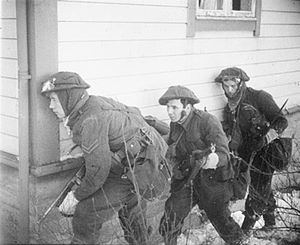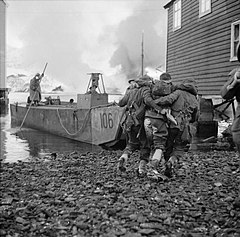Operation Archery
| Operation Archery | |||||||
|---|---|---|---|---|---|---|---|
| Part of World War II | |||||||
 Commandos in action during the raid. | |||||||
| |||||||
| Belligerents | |||||||
|
|
| ||||||
| Commanders and leaders | |||||||
|
| |||||||
| Strength | |||||||
|
1 cruiser 4 destroyers air support 570 men |
coastal fortress unknown number of ships air support 150 infantry, one tank, 100 men of the German Labour Corps | ||||||
| Casualties and losses | |||||||
|
22 killed 57 wounded |
estimated 120 killed 98 captured 10 ships sunk | ||||||
Operation Archery was a British Combined Operations raid during World War II against German positions on Vågsøy Island, Norway on 27 December 1941.
The raid was conducted by British Commandos of No. 3 Commando, two troops (platoons) of No.2 Commando, a medical detachment of No.4 Commando, a demolition party from 101 Troop (canoe) of No. 6 Commando and a dozen Norwegians from Norwegian Independent Company 1. The action was supported by Royal Navy gunfire, led by the cruiser HMS Kenya, with the destroyers HMS Onslow, HMS Oribi, HMS Offa and HMS Chiddingfold.[1] The submarine HMS Tuna was in support as the force navigational check.[2] For troop transport HMS Prince Charles and HMS Prince Leopold were used.[1] Also in support were Royal Air Force bombers and fighter-bombers.
Objectives
The Commando force of 570 troops was divided into five with these objectives.
- (1) Secure the area north of the town of Måløy on South Vågsøy and engage any enemy reinforcements;
- (2) subdue and secure Måløy town;
- (3) eliminate the enemy on Måløy Island (Moldøen, "Øyna") which dominated the town;
- (4) eliminate the enemy strongpoint at Holvik south of Måløy;
- (5) provide a floating reserve offshore.
Central to the operation was the destruction of fish-oil production and stores which the Germans used in the manufacture of high explosives. Another intention was to cause the Germans to maintain and increase forces in Norway which otherwise might be employed on the Eastern Front.
Raid
The dawn landing was preceded by a very effective naval bombardment and objectives went according to plan except in the town of Måløy itself. Opposition there was much stiffer than expected as unknown to the British, a gebirgsjäger (mountain troops) unit of experienced troops from the Eastern Front was there on leave. As the landing craft hit the beach, Major Jack Churchill was playing The March of the Cameron Men on the bagpipes.[3]
Their experience in sniping and street fighting caused the operation to develop into a bitter house-to-house battle. This caused the commander, John Durnford-Slater, to call in the floating reserve and troops from Vågsøy Island. A number of local citizens assisted the Commandos by acting as porters for ammunition, grenades and other explosives, and in carrying away the wounded.
At around 14:00 the Commandos started their withdrawal having destroyed four factories, the fish-oil stores, ammunition and fuel stores, the telephone exchange and various military installations. Much of the town was in flames. The Naval assault force of one cruiser and four destroyers had meanwhile sunk 10 vessels, some found in the act of being scuttled to prevent capture.
Outcome

No Royal Navy ships were lost, but the Navy suffered four men killed and four wounded. The Commandos sustained 17 killed and 53 wounded, the commander of the Norwegians, Capt. Linge, was killed in an attack on the local German headquarters, and the RAF had eight planes downed. The Commandos accounted for at least 120 enemy killed and returned with 98 prisoners and a complete copy of the German Naval Code. Several Quislings and a number of loyal Norwegians were also brought back. The wounded man being taken to the landing craft is Captain O'Flaherty who was shot in both eyes by a German sniper. He lost one eye and wore a black eyepatch thereafter. He died in the late nineties. A photo [1] of him being helped by two soldiers is in the archives, flanked by commando Derek Page with his rifle and bayonet. In conjunction with this raid, Operation Anklet was mounted by No. 12 Commando on the Lofoten Islands as a diversion.
The raid was enough to persuade Adolf Hitler to divert 30,000 troops to Norway, upgrade coastal and inland defences. Hitler thought that the British might invade northern Norway to put pressure on Sweden and Finland.
See also
Notes
- ^ a b London Gazette, July 2, 1948.
- ^ Combined Operations: Operation Archery
- ^ Young, Peter. "Commando", 1969. Ballantine Books
